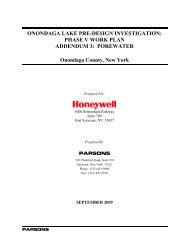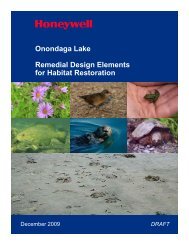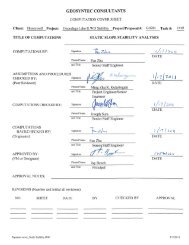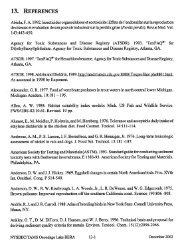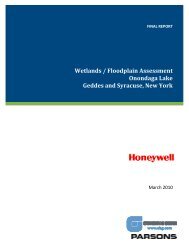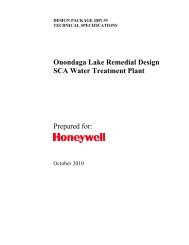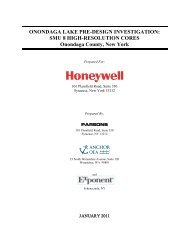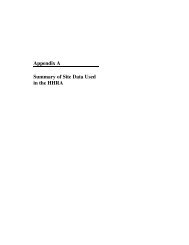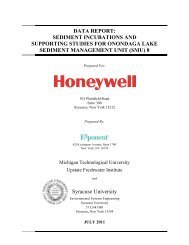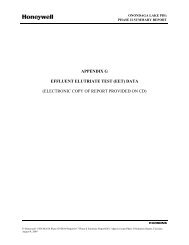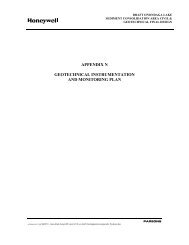Phase 1B Underwater Archaeological Report for the Onondaga ...
Phase 1B Underwater Archaeological Report for the Onondaga ...
Phase 1B Underwater Archaeological Report for the Onondaga ...
You also want an ePaper? Increase the reach of your titles
YUMPU automatically turns print PDFs into web optimized ePapers that Google loves.
FINAL<br />
<strong>Phase</strong> IB <strong>Underwater</strong> <strong>Archaeological</strong> Resources <strong>Report</strong> <strong>for</strong> <strong>Onondaga</strong> Lake Superfund Site<br />
Anomaly 7: Piling Clumps<br />
Anomaly 7 Summary Table<br />
Anomaly Identification Piling Clumps; NY Site Number 06740.012295<br />
Remedial Impact<br />
Dredging and Capping<br />
NRHP Eligibility<br />
Eligible as Contributing Property to Syracuse Maritime Historic District<br />
Recommendation<br />
Anomaly Dataset<br />
Side Scan (2005) 130, 169, 150, 191, 202<br />
Magnetometer (2005) 819, 795, 220, 809, 794, 731<br />
Side Scan (2010) 6/3/10<br />
Sector Scan (2010) 6/5/10<br />
ROV Video Footage (2010) None<br />
Diver Observations No<br />
Diver Videography<br />
No<br />
Maps/Charts<br />
Yes<br />
Aerial Imagery<br />
Yes<br />
Historic Accounts<br />
No<br />
Research Results<br />
Anomaly A7 was identified from aerial images and <strong>the</strong> 2005 remote sensing survey (Figure 48). The<br />
anomaly is a series of six piling clumps marking <strong>the</strong> entrance into Syracuse’s inner harbor. The clumps<br />
consist of between three and ten pilings driven into <strong>the</strong> lakebed and held toge<strong>the</strong>r with cables and/or<br />
iron bands. The clumps are visible above <strong>the</strong> surface, and were documented with side scan sonar,<br />
sector scan sonar and photographs (Figure 49 and Figure 50).<br />
Analysis of historic navigational charts suggests that this channel was first marked with two lighted aids<br />
to navigation between 1915 and 1926, and an additional set of piling clumps was installed between<br />
1937 and 1942. 134 The 1952 navigational chart continues to show four piling clumps; however, modern<br />
charts show <strong>the</strong> six that currently exist.<br />
Statement of Significance<br />
In 1993, <strong>the</strong> New York State Office of Parks, Recreation and Historic Preservation evaluated <strong>the</strong> New<br />
York State Canal System and found it to be eligible <strong>for</strong> <strong>the</strong> NRHP (see Appendix 5). 135 This resource<br />
evaluation found <strong>the</strong> New York State Canal System to be <strong>the</strong> most extensive canal system in North<br />
America. It is of national significance <strong>for</strong> <strong>the</strong> roles it played in <strong>the</strong> growth and development of New York<br />
State, <strong>the</strong> upper Midwest, and <strong>the</strong> nation. Contributing properties (assuming adequate integrity) include<br />
any canal-related feature including, but not limited to, built engineering features, navigational aids,<br />
maintenance fleets, boat wrecks, and terminals and/or structures associated with <strong>the</strong> canal whe<strong>the</strong>r<br />
publicly or privately constructed or owned.<br />
Although it is unlikely that anomaly A7 meets <strong>the</strong> minimum 50 year threshold <strong>for</strong> a contributing<br />
property to <strong>the</strong> NHRP, <strong>the</strong>se pilings are a contemporary extension of historic transportation facilities<br />
and aides to navigation which were routinely replaced. This taken into account with A7’s location within<br />
<strong>the</strong> Syracuse Maritime Historic District, LCMM recommends that A7 is a contributing property to this<br />
District.<br />
69



